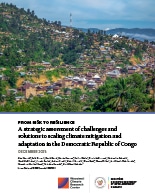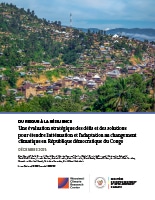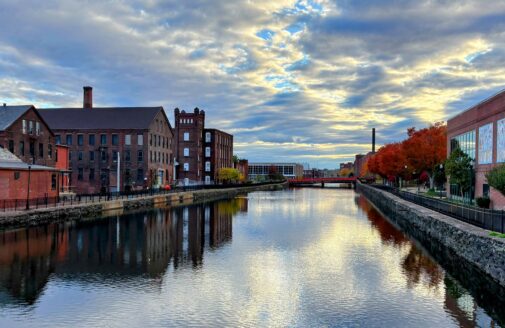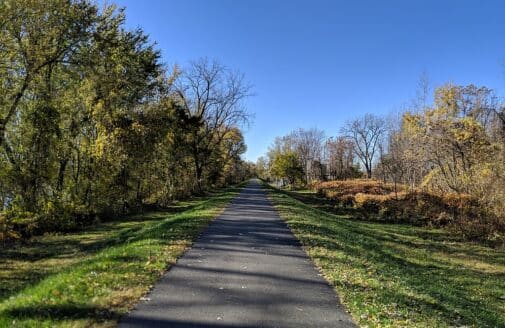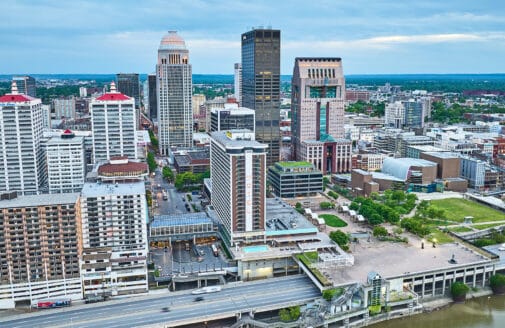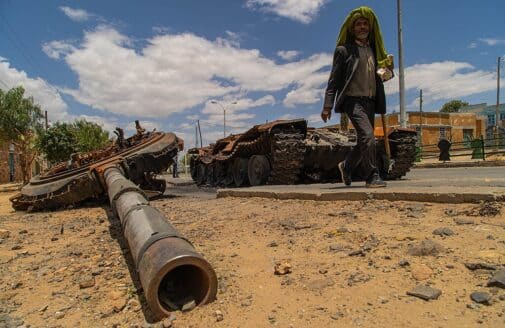From risk to resilience: An assessment of the DRC
A strategic assessment of challenges and solutions to scaling climate mitigation and adaptation in the Democratic Republic of Congo
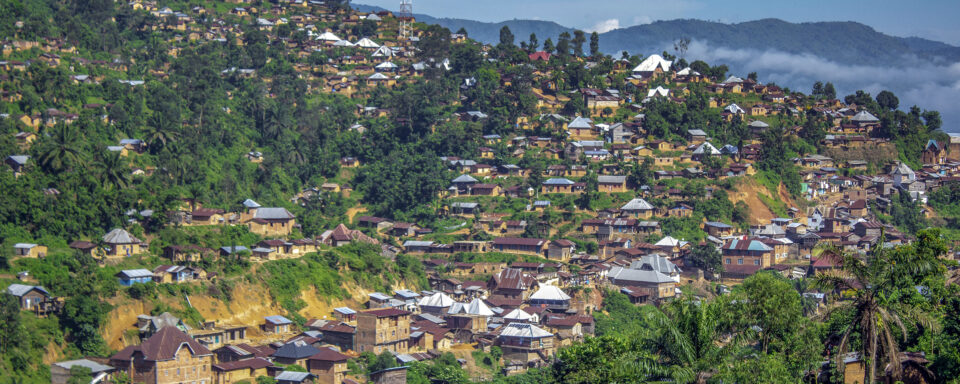
Introduction
The impacts of climate change on the frequency and severity of physical hazards are putting many communities at risk. As the threat of climate change grows, so too does the need for accessible information, tools, and expertise to support climate-resilient decision making across multiple scales, from communities to countries. Woodwell Climate Research Center believes there is a need to localize and customize climate risk assessments. This information is critical for government leaders as they make planning decisions, but it is not available to all that need it. Woodwell Climate believes that this science should be freely and widely available. To address this gap, Woodwell Climate works with communities and countries across the world, including the Democratic Republic of the Congo, to provide climate risk assessments, free of charge.
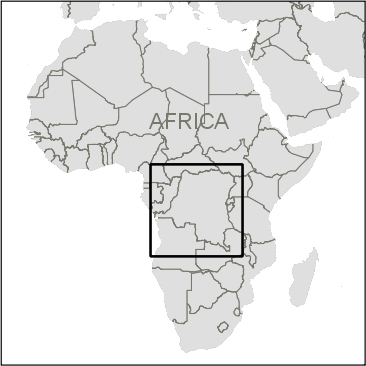
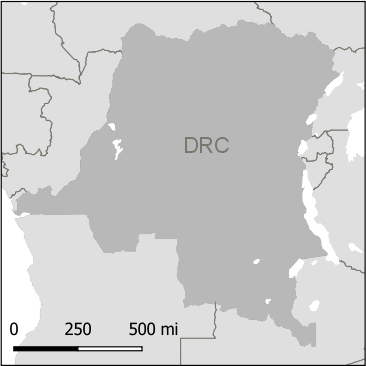
Policy context
The Democratic Republic of Congo (DRC), straddles the equator, covering 2,345,409 km2 (905,567 square miles) and covers most of the Congo Basin. The population is estimated to be more than 90 million inhabitants, with an annual population growth rate of 3.1%. The DRC has said that it is committed to the United Nations’ 2030 Agenda for Sustainable Development and has adopted its National Strategic Development Plan for the period 2019–2023 (NSDP), which is aligned with the Sustainable Development Goals (SDGs).
The NSDP outlines key phases of development to 2050 and is structured around five main pillars:
Pillar 1 | Development of human capital, social and cultural development;
Pillar 2 | Strengthening governance, restoring state authority and consolidating peace;
Pillar 3 | Consolidation of economic growth, diversification and transformation of the economy;
Pillar 4 | Land use planning, reconstruction and modernization of infrastructure; and
Pillar 5 | Environmental protection, the fight against climate change and sustainable and balanced development.
The environmental protection and climate change pillar (Pillar 5) is cross-cutting and aims to integrate environmental issues and climate change concerns across government in order to achieve resilient and low-carbon development. Tropical forest conservation, in particular, is key to national efforts to reduce emissions. To achieve these goals, the Ministry of Environment and Sustainable Development (MEDD) coordinated the development of the Climate Change Policy, Strategy and Action Plan.
The National Adaptation Plan (NAP), for the period 2022–2026, was developed to strengthen the country’s resilience and to integrate climate change adaptation into planning and budgeting at both the national and provincial levels.
Policy alignment
In 2022, Woodwell Climate began consultations with officials in the Ministry of Environment and Sustainable Development (MEDD) and the University of Kinshasa to identify climate resiliency priorities. Climate change threats to forests and forest carbon were identified as critical because of DRC’s plans to engage in global carbon markets and because of the key role that forests play in the country’s nationally determined contribution.
Those discussions identified how a climate risk assessment could be made relevant to the DRC’s policy priorities of forest conservation and sustainable development. The DRC National Adaptation Plan 2022–2026 (2021; Section 3.4) identifies the connection between climate risk and other environmental goals. Nature-based Climate Solutions (NbCS) encompass a range of landscape protection, improved management, and restoration activities that are essential to deliver on global emissions reduction targets. Many nature-based opportunities exist across the DRC, spanning the economically and socially diverse provinces. The ways in which climate risk intersects spatially with this potential is a key focus of this risk assessment.
In early 2023, MEDD and Woodwell Climate undertook a climate risk assessment exercise, with a primary focus on climate change threats to forest carbon and agriculture. The assessment examined a range of climate change hazards, and identified critical gaps in national capacity for data acquisition, application and sharing. The intention is for this assessment to support adaptation planning efforts, and to enhance integrity in the supply of internationally traded carbon credits. Scaling finance mechanisms aimed at investment in NbCS will help drive critical funding to support a new climate economy.
Results summary
The NAP (2021) considers large-scale climate impacts on the DRC, but granular climate risk assessments are needed to inform localized adaptation planning. To this end, the NAP calls for the implementation of more risk assessments—including more detailed assessments and those carried out by external partner organizations—and states this need as a fundamental priority (2021, Sections 4.3, 4.4). The high-resolution (downscaled to at least 0.25°) and bias-adjusted (using historical reference data) climate risk analysis presented here can contribute to this national priority. Our analysis is primarily based on the latest projections from the Coupled Model Intercomparison Project (CMIP6)—a vast improvement from the analysis based on CMIP3-era data presented in the NAP (2021). The primary climate risks identified in the NAP (2021) include abundant rainfall, rising temperatures, and drought, which we have included in our report. Additionally, our analysis includes downstream impacts, such as heat impacts on mortality and labor productivity, and the impact of changing temperature and precipitation seasonality on principal subsistence (cassava) and exported (coffee) crops.
Here we present our findings on drought, heat stress, agricultural yields, extreme precipitation, flooding, and wildfire to help the Democratic Republic of the Congo in its plans to create a more resilient future for all residents. These risks were selected through participatory working group discussions to define priorities and issues during the first workshop (December 2022). They reflect case studies around how critical future climate factors will interact with selected key natural resources and economic infrastructure in order to guide discussion around strategic pathways to mitigate and adapt to climate change and develop a resilient economy. The analysis provided inputs into the second workshop (May 2023) where additional key issues and refinements to the models were identified. In the final workshop (October 2023), the updated analysis was reviewed and breakout groups discussed their implications for policy and practice.
As a result of climate change, drought is expected to increase across most of the country, with some areas set to experience severe drought conditions on a near year-round basis between now and mid-century. Heavy rainfall is also projected to intensify with the historical 100-year rainfall event becoming a 1-in-30 year event for the DRC by mid-century and a 1-in-15 year event by late-century. By simulating present and future rainfall and riverine flooding, we see that 300 km2 of Kinshasa is inundated during the present-day 100-year flood, 365 km2 is inundated by mid-century, and 403 km2 by the late-century. Wildfire danger days will also increase for much of the DRC. The southeastern region of the country could see an almost 200% increase in days with high wildfire potential, while a few areas—mainly in the north—will see a slight decrease in wildfire danger. Models of the impact of climate change on cassava and coffee productivity suggest that suitable conditions for the cultivation of these crops will decline in general, although with regional differences in magnitude.




